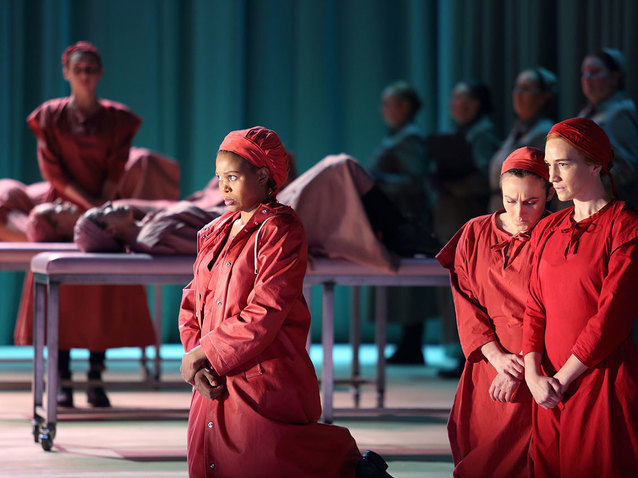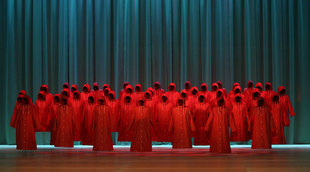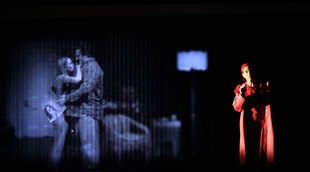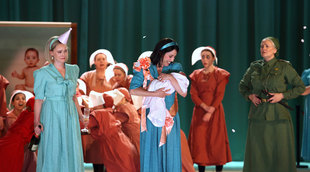 © Catherine Ashmore
© Catherine Ashmore
Written in 1998 to a libretto by Paul Bentley, Poul Ruders’s The Handmaid’s Tale is based on Margaret Atwood’s eponymous novel of 1985. This means that when he wrote it no one had even heard of Bruce Miller’s television series that aired in 2017.
With some qualifications, the opera follows the same plot as the novel in painting a nightmarish vision of the early twenty-first century, which then still lay in the future. It is a world in which a supposedly stringent, moral orthodoxy has been reasserted, but clearly for self-serving reasons. In this way, the ruling classes, and particularly men, use allegedly Christian messages and biblical passages to uphold an order that serves their own needs. They brainwash those they rule over into accepting and obeying rules that they flout themselves on the grounds that it is safe for them to do what it would be disastrous to allow the masses to pursue. It consequently represents a reversion to the types of order that have existed in many times and places.
The particular focus is a ‘class’ of women known as handmaids. They have committed some form of impropriety, as judged by this society, and been sent on a ‘reform programme’. This sees them enter childless households where they are ritually inseminated once a month by the husband in order to have a baby in place of the wife who is supposedly barren. The handmaids are made to believe, and consequently oft repeat, that there is no such thing as a sterile man, and yet clearly this is not the case. If the wife is unable to have a child, it will often be because the husband is impotent, and yet it is the handmaid who pays the price because if she is also unable to produce offspring she is threatened with expulsion to the ‘colonies’. Again, it is part of a deception that is privately admitted as a doctor offers to ‘help’ a handmaid because he knows the truth, and a wife tries to organise a ‘contingency’ to ensure that ‘her’ handmaid does become pregnant.
The story focuses on one handmaid who becomes known as Offred (‘Of Fred’ referring to the man of the family to which she is posted). It is told from the perspective of the year 2195 when a symposium looks back on the Republic of Gilead (the name of the ‘theocracy’ that existed in the early twenty-first century) and considers some cassette tapes left behind by Offred. They are the only record of her existence, and provide vital clues as to her life. They do not, however, tell us everything for, while they make it clear she joined an underground resistance movement and attempted to escape over the ‘wall’ that marked the boundary to the regime, they do not reveal what happened to her.
The novel works well in operatic form since Ruders’s music proves perfect at conveying the sheer sense of emptiness that the handmaids feel on the one hand, and the most climatic moments on the other. In fact, at several shocking points, which include a ritualistic insemination, the score includes a ‘dysfunctional’ version of ‘Amazing Grace’ that heightens both the irony and pathos. There are, however, differences between the opera and novel as Bentley’s libretto tells the story in the third, rather than first, person. Similarly, in the original the reader only learns at the end that the text comes from reconstructing 200-year old cassettes, while here the symposium that frames the drama explains this at the start. This is presumably because points have to be made simpler and bolder in opera. The mystery element that works so well in literature could leave audiences engaging less with the characters during the performance if they do not hook in as much to what is actually happening.
English National Opera previously performed the work in 2003, but this new production constitutes Annilese Miskimmon’s first for ENO since she became its Artistic Director. It is a staging that suits the mood of the piece well with curtains at the back and sides, and generally few props, creating both an enclosed and stark area for the drama. In Annemarie Woods’ set, a further curtain often drops across the stage, which suggests that the handmaids are only being shown what those in power want them to see, and makes us also question what is being hidden. Scenes from Offred’s own past are projected onto this curtain, with her mother espousing the types of causes that we might typically think of as being fought for in the sixties.
The audience is immersed in the scenario before the opera even begins as announcements are made for them to take their seats not for an opera, but for the symposium that is about to begin. The stage carries a huge banner welcoming delegates to the Twelfth Symposium on the Republic of Gilead, while handmaids’ red hoods hang on the stage, emphasising how in the year 2195 they are, as individuals, unknown, faceless and nameless. Then the speaker Professor Pieixoto, played by Camille Cottin, explains what happened in that early part of the twenty-first century and about this one handmaid’s tapes (this is in the original opera), before we are taken back in time to see her for ourselves.
Some scenes are executed especially well so that one sees Offred sing while behind her all the handmaids queue for their ‘check-up’ with the doctor, each shunting along one chair or standing position as the next goes in to see him. Others are used to show how a pretence is maintained that the child borne by the handmaid really belongs to the wife by putting the latter as centre-stage as is possible during the insemination ritual and birth. The sight of a handmaid vainly reaching for her newborn baby as it is passed to the wife, and she is shunted out of sight, is particularly poignant.
One does, however, feel that a trick is missed in the portrayal of Jezebel’s, a private club where ‘faltering’ women can become prostitutes as an alternative to becoming a handmaid. Here the women are seen wandering aimlessly as their spirit has been totally broken, but it may have been more effective to have made the scene ostensibly upbeat so that we had to search for the horror that lay beneath the apparent glitz and glamour. To an extent, however, the music itself does not allow for such a multi-layered approach, and if there is one criticism of this still brilliant score it is that it is too unrelenting and stark throughout. One only has to think of the way in which Kurt Weill sometimes uses jolly music in his Rise and Fall of the City of Mahagonny to highlight scenarios that are far from happy, to wonder if a greater degree of variety might have been welcome in this instance.
The excellent ensemble cast includes Emma Bell as Aunt Lydia, Pumeza Matshikiza as Moira, Rhian Lois as Janine, Susanna Tudor-Thomas as Moira’s Aunt, Avery Amereau as Serena Joy, Robert Hayward as The Commander, Madeleine Shaw as Rita, Frederick Ballentine as Nick, Ellen Pritchard as Ofglen, Alan Oke as The Doctor and John Findon as Luke. The highest accolades, however, have to go to Kate Lindsey as Offred. In her immensely thoughtful and sensitive portrayal, her mezzo-soprano proves to be both clean enough to generate some beautifully pure lines and nuanced enough to give these infinite shape and colour. Her duet with her younger self is one of the undoubted highlights of the evening, while the conducting of Joana Carneiro also proves to be highly persuasive.
By Sam Smith
The Handmaid’s Tale | 8 - 14 April 2022 | London Coliseum
the 13 of April, 2022 | Print



Comments